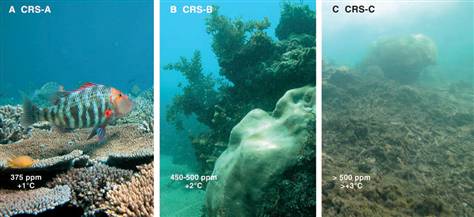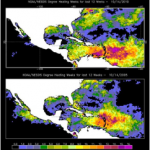
![]() When you’re in the biodiversity conservation biz for any significant length of time, you inevitably develop a thick skin to grim pronouncements of ecosystem collapse from the scientific community. It’s a coping mechanism. Coral reef conservation, in particular, is not a place for overly delicate sorts. Nary a week passes without some fresh obituary being written about reefs. And this week is no exception. But even this news gave me pause.
When you’re in the biodiversity conservation biz for any significant length of time, you inevitably develop a thick skin to grim pronouncements of ecosystem collapse from the scientific community. It’s a coping mechanism. Coral reef conservation, in particular, is not a place for overly delicate sorts. Nary a week passes without some fresh obituary being written about reefs. And this week is no exception. But even this news gave me pause.
A paper published September 29 in Environmental Research Letters by a group of international scientists from seven European research centers has found that even if nations would agree to a 50% reduction of emission levels by 2050 there would still only be a less than 50% chance to keep global warming below 2 º C.
The authors, who first pointed out the paltry emissions targets last Spring, argue that if national emissions targets are not revised to more aggressive levels that limit global warming below 2 º C (and even more preferably 1.5º C), a global temperature increase of up to 4.2 º C could become reality by 2100.
And what are the climatic impacts under this scenario? In a word, “catastrophic” for coral reefs:
“Rising global average temperature levels are not the only possible “dangerous anthropogenic interference with the climate system”. For example, increasing atmospheric CO2 levels cause increasing ocean acidification and will adversely impact marine ecosystems (Doney et al 2009, Hoegh-Guldberg and Bruno 2010). A recent study (Veron et al 2009) defines an atmospheric CO2 concentration of below 350 ppm CO2 as a long term safe limit needed for coral reefs, while a CO2 concentration of 450 ppm CO2 would cause reefs to be in rapid and terminal decline. Silverman et al (2009) indicate furthermore that coral reefs cease to grow and start dissolving at 560 ppm CO2. Both in Arctic (Steinacher et al 2009) and Antarctic (McNeil and Matear 2008) oceans, aragonite undersaturation – causing calcium carbonate shells beginning to dissolve – is projected to occur at atmospheric concentration levels of 450 ppm CO2. For Case 1 and without a 2050 target, median estimates would exceed the 450 ppm CO2 threshold in approximately 2030. The 560 ppm CO2 threshold is very likely exceeded by the end of this century. Even for Case 2 (with a global 2050 target and exponential decline afterwards), estimated likely CO2 levels (408 to 475 ppm CO2) would imply a rapid decline of coral reefs and arctic aragonite undersaturation during the 21st century. Continuous mitigation effort through the entire century and beyond will be necessary to return atmospheric CO2 concentrations to a level considered safe for marine ecosystems.”
As I’ve written about before, increased atmospheric CO2 and other greenhouse gas levels will create a 1-2 punch to reef-building corals. First, elevated sea surface temperatures will lead to more frequent and widespread mass coral bleaching events as are now happening throughout the Indo-Pacific and Caribbean. Second, the creeping yet insidious threat of more acidic oceans from CO2 saturation in seawater will begin dissolving existing solid reef architecture as well as make new coral recruitment difficult to impossible. These climate-driven global threats to coral reefs are on top of more localized threats such as destructive fishing practices, coastal development, and recreational impacts to reefs.
And the potential impacts will extend much further than just coral reefs. We all receive direct or indirect benefits from healthy coral reef ecosystems. Most of these ecosystem services are driven by the incredible biodiversity found on coral reefs. Estimates show that reefs are home to 25% of ocean species. Healthy reefs provide the primary source of protein to over 1 billion people globally. Healthy reefs protect coastal areas from the severe impacts of hurricanes and other storms. Fifty percent of all current cancer research is exploring the benefits of chemical compounds isolated from species found on coral reefs. And coastal tourism in coral reef destinations is the backbone of many national economies, generating 27 times more income than global fisheries combined.
If coral reefs collapse, the life support system of many nations collapse as well. What we collectively might face is a humanitarian crisis of unprecedented proportion.
So how did we get to this precipice? By one step at a time.
In December 2009 in Copenhagen, representatives of 193 governments gathered at the 15th session of the Conference of the Parties (COP15) of the United Nations Framework Convention on Climate Change. The conference resulted in the ‘Copenhagen Accord’ which was negotiated as part of a closed negotiating segment by 26 nations.
In the Accord, Parties
“[…] agree that deep cuts in global emissions are required according to science, […] with a view to reduce global emissions so as to hold the increase in global temperature below 2 degrees Celsius” and hereby preventing “dangerous anthropogenic interference with the climate system”.
But as the authors of today’s paper point out, the Copenhagen Accord and the pledges made under it reveals weak national ambition levels and represents a set of dissonant ambitions,
The ambition level of the current pledges for 2020 and the lack of commonly agreed goals for 2050 place in peril the Accord’s own ambition: to limit global warming to below 2°C. […] the net effect of current Accord pledges would globally not stimulate any actions beyond those which were already in place before COP15.
Complicating matters further, as the Copenhagen Accord has no legally-binding character, parties can add, modify or withdraw their submitted emissions limit pledges or actions without any restriction.
For reference and and as a reminder, developed countries such as the USA and the European Union have indeed set their CO2 emissions targets very low, aiming at reaching emission levels just a few percent lower than 1990 levels by 2020. If other nations were hoping to take a cue on their own climate change decision-making based on US or the EU leadership, special interests and the climate change denialist nuts have effectively gummed up that possibility. Only Japan and Norway are aiming to drastically reduce their emission to 25% and 30 to 40% below 1990 levels respectively.
[As a loosely-related aside, Japan and Norway, both active whaling nations, could take a more significant step towards their climate commitments and be true global climate change leaders by leaving a few more whales alive in the oceans. But that’s an ocean obituary story for another day.]
So, should I hang up my hat and look into hitching my conservation wagon to a winner like manatees or sea otters?
Not quite yet, suggest the authors,
“With the negotiation mandates having been extended to the end of 2010, committing to higher ambitions and agreement by all Parties still remains possible.”
As the authors indicate, higher ambitions for 2020 are needed to still keep the possibility for a 2°C and 1.5°C warming limit alive. They also point out that Accord nations need to establish a meaningful and unambiguous mid-century emission goal as a metric by which to monitor decadal progress towards that goal.
The next meeting of the UN Conference of the Parties (COP16) is scheduled for early December in Cancun, Mexico. The irony that COP16 will be meeting in a coral reef destination and region which relies upon healthy reefs for their survival is not lost on me. I hope it is not lost on the COP16 delegates.






The anthropogenic alteration of the ocean’s carbonate chemistry is really a mind-blowingly scary impact. And the way things are going, looks like Ove HG might have been right when he suggested over a decade ago that massive bleaching events may intensify and get more frequent.
The real villain here is rapid climate change and that must be mitigated; but MPAs can protect coral cover loss from local stressors. Is there any evidence that reserves could render reefs more resilient to chemical and climate changes?
Well-managed MPAs (not simply those that are legislatively protected on paper) will play an important role in local resilience-building of coral reef systems. However a recent study published at PLoS ONE (http://www.plosone.org/article/info%3Adoi%2F10.1371%2Fjournal.pone.0003039) indicates that marine reserves will not, by themselves, prevent further coral losses due to ocean warming.
Active management will, in my opinion, be key to buying time however.
http://www.theecologist.org/News/news_round_up/614395/coral_reefs_could_disappear_by_2100.html